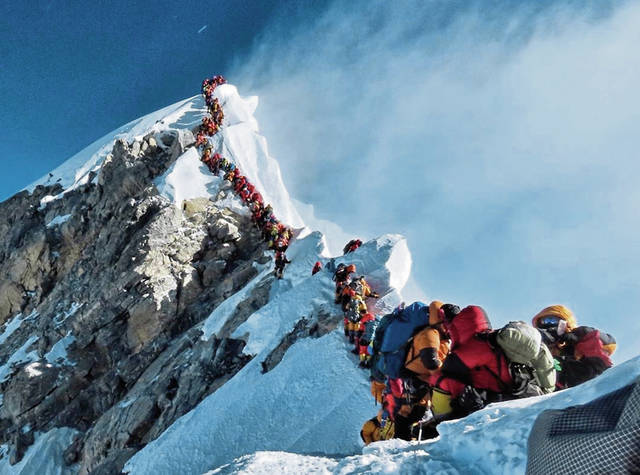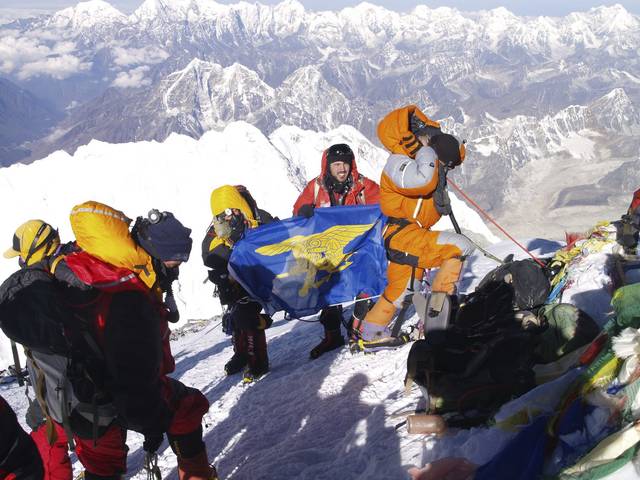Pittsburgh climbers hope for government action over Mount Everest deaths
Sushil Acharya thought the image of a logjam of hikers snaking a wicked ridge along Mount Everest was Photoshopped.
“I’ve never seen a picture like that,” said the Robert Morris University professor, who was born in Kathmandu. “I thought it was fake news.”
The now-iconic photograph exposed the stunning sight of mountaineers, crammed crampon-to-crampon, on a stretch of Mount Everest called “the death zone.”
Western Pennsylvanians with Nepali roots and those with ties to the climbing community joined the growing chorus this week for the Nepalese government to limit the number of permits amid the deadliest season since 2015, when an avalanche killed 19.
“I’m hopeful that the government will do something,” Acharya said.
To date, 11 climbers — including 62-year-old Colorado attorney Christopher John Kulish on Monday — have died on Everest this year. Most of the dead are believed to have succumbed to altitude sickness, an illness typically acquired 8,000 feet above sea level that consists of symptoms including dizziness, nausea, fatigue and impaired mental acuity. Prolonged time at higher altitudes also can trigger a lethal buildup of fluid in the lungs.
The Nepali government approved a record number of climbing permits this year, 381. A permit for a foreigner costs $11,000. Nepali officials signaled earlier this week that they are not yet considering a move to tighten rules for climbers.
“The Nepalese government is in the position to strike the balance,” said Will Cross, who summited Everest in 2006 after two failed attempts. “But, I doubt the Nepalese government will take it.”
Some have blamed a shorter climbing window. Mount Everest is home to notoriously fickle and precarious weather that can cut an already short climbing season down to a matter of weeks or days. Others, including climbers and the western outfitters who support them, blame the rise of low-cost guide services and companies.
Treks up Everest were once relegated to elite mountaineers who could shoulder costs in excess of $50,000 for western outfitters to provide guided support to scale the world’s tallest peak. Climbers told the Tribune-Review that local companies have cut those expenses in half.
“The climbers who are slowing everybody down, they usually are not professional climbers, and they usually belong to Nepalese outfitters,” said Michael Kobold, 40, owner of Kobold Expedition Tools and a Carnegie Mellon University graduate who scaled the peak in 2009 and 2010. “You’ve got weak mountain guides leading weak climbers.”
Kobold, who lived in Nepal the past three years and is working on a documentary, put the blame there and not on the shorter weather window. Cross, a Pittsburgh-based motivational speaker, agreed. He was hesitant to blame the Nepalese companies and instead pointed the finger at the climbers looking for a cheap trip up Everest.
“It’s very easy to blame the Nepalese for the problem,” said the 52-year-old member of the so-called “Seven Summits Club” of hikers who have climbed the highest peak on each continent. “I don’t think that it’s fair. I think the blame lies with the buyer.”
A cheap excursion might cut costs with oxygen cylinders of dubious quality purchased on the black market or guides who don’t speak English. The choice to go with a cheaper alternative, climbing enthusiasts said, could prove deadly.
Climbers, however, didn’t fault local guides, who can make in a single trip up the mount what the typical Nepalese earns in a year. One of the poorest countries on the globe, Nepal’s economy relies on the mountaineers who come every year to scale the highest peaks in the world.
“This has now become the economy of Nepal,” said Maggie Schneider, assistant director of the Dietrich School of Arts & Sciences. Schneider spent several days at Everest’s base camp in 2004. “If you break the established line of money coming into the country, not only do you put the government at a disadvantage, but the people, too.”
The allure of the mountaintop has wooed thrill seekers since Edmund Hillary became the first recorded explorer to crest Everest on May 29, 1953. The recent deaths, climbers said, aren’t likely to deter that.
“So many people want to set so many records,” Dr. Prativa Pandey, a Nepali physician who works at the CIWEC Clinic, a travel medicine center in Kathmandu that treats Everest rescues, told the Trib. “I wonder how people make it.”
Remove the ads from your TribLIVE reading experience but still support the journalists who create the content with TribLIVE Ad-Free.


